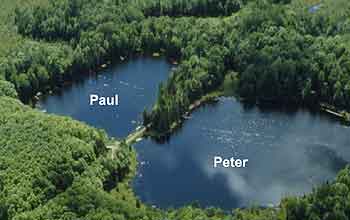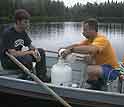News Release 04-004
If We Are What We Eat, Some Lake Fish Are Made of Maple Leaves
Study Shows Fallen Leaves Play a Role in the Food Web.
January 14, 2004
This material is available primarily for archival purposes. Telephone numbers or other contact information may be out of date; please see current contact information at media contacts.
Arlington, Va.—Aquatic plants form the base of the food web. The energy they create supports aquatic life, from invertebrates to the largest sport fish. Now, a study shows that aquatic plants are receiving a little help from trees. In a paper in this week's issue of the journal Nature, Michael Pace and Jonathan Cole of the Institute of Ecosystem Studies in Millbrook, New York, along with colleagues from Wisconsin and Sweden, indicate that a significant part of the aquatic food chain is supported by terrestrial organic matter that originates on shore.
A building block of life, organic carbon is essential to aquatic food webs. In lakes, aquatic plants produce organic carbon by harnessing the sun's energy (photosynthesis); some of this carbon supports the growth of fish and invertebrate populations. Scientists have long suspected that organic carbon from land is also significant to aquatic life, but the idea is difficult to demonstrate. By tracing the fate of carbon through large-scale lake manipulations, Pace, Cole, and their colleagues have revealed that in some waters terrestrial organic carbon significantly subsidizes the aquatic food web.
"These scientists have found an ingenious method of teasing apart the carbon cycle of lakes," says James Morris, program director in the National Science Foundation (NSF)'s division of environmental biology, which funded the research. "Their study reveals a surprising degree of dependence of lake food webs on sources of organic matter transported into the lakes from the surrounding watershed. These findings reinforce the concept that the ecology of lake ecosystems is tightly coupled with that of the surrounding terrestrial landscape."
That maple tree leaves many eventually become perch, and that the vegetation around a water body can have profound impacts on the animal life within the body of water blur the perceived ecological boundaries between aquatic and terrestrial systems.
The impetus behind the study, which involved manipulating two Michigan lakes, was to better understand the aquatic food chain. Pace explains, "We wanted to reveal what many ecologists have long thought- aquatic life is partly dependent on organic matter produced in the watershed." Using a chemical tracer, Pace and his colleagues set out to quantify this assumption. "The moral of the story," Pace comments, "is, yes, fish are made from algae, but fish are also partly made from maple leaves."
In Lakes Peter and Paul located at the University of Notre Dame Research Center, the scientists tested whether lake plant production was sufficient to support resident aquatic life.
They found that 40-55 percent of particulate carbon and 2250 percent of zooplankton (small animals that live in the water column) in the lakes are derived from terrestrial sources, which confirms that terrestrial carbon fuels aquatic production. The carbon in the zooplankton reflects their dependence on both lake plant production and terrestrial organic matter. Zooplankton are a dietary staple of many fish, especially in very young life stages.
"Our results," notes Cole, "tell us there is not nearly enough aquatic carbon to support these animals. They are dependent on terrestrial inputs."
Pace comments, "We now have direct experimental evidence that confirms that aquatic food chains are supported not just by the production of plants in the water but also by the production of plants on the land surrounding lakes and ponds. The leaves and organic matter that enter lakes are ultimately incorporated into aquatic animals." These findings challenge traditional views of the aquatic food web and may help watershed managers. "Organic matter from the watershed subsidizes lake food webs, allowing more animal life in the lakes than if they were simply isolated water bodies," Pace concludes.
-NSF-
-
Scientists conduct research in study lakes.
Credit and Larger Version
Media Contacts
Cheryl Dybas, NSF, (703) 292-7734, email: cdybas@nsf.gov
Program Contacts
James Morris, NSF, (703) 292-8481, email: jmorris@nsf.gov
The U.S. National Science Foundation propels the nation forward by advancing fundamental research in all fields of science and engineering. NSF supports research and people by providing facilities, instruments and funding to support their ingenuity and sustain the U.S. as a global leader in research and innovation. With a fiscal year 2023 budget of $9.5 billion, NSF funds reach all 50 states through grants to nearly 2,000 colleges, universities and institutions. Each year, NSF receives more than 40,000 competitive proposals and makes about 11,000 new awards. Those awards include support for cooperative research with industry, Arctic and Antarctic research and operations, and U.S. participation in international scientific efforts.
Connect with us online
NSF website: nsf.gov
NSF News: nsf.gov/news
For News Media: nsf.gov/news/newsroom
Statistics: nsf.gov/statistics/
Awards database: nsf.gov/awardsearch/
Follow us on social
Twitter: twitter.com/NSF
Facebook: facebook.com/US.NSF
Instagram: instagram.com/nsfgov




